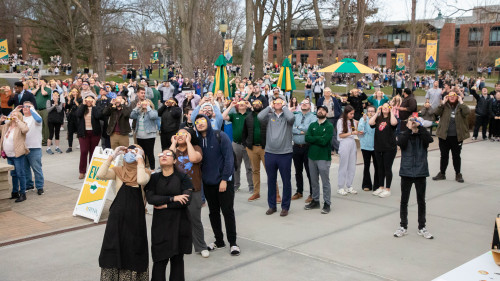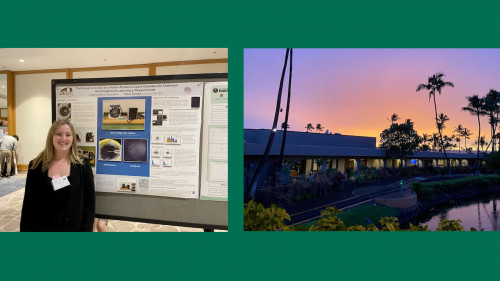
Professor and students were all set to observe distant galaxies and supermassive black holes through remote access to the Kitt Peak National Observatory near Tucson, Arizona. A 20,000-acre wildfire ignited by a June 11 lightning strike unfortunately scrapped those plans, but they were able to pivot to a new summer study option.
John Moustakas, Ph.D., associate professor of physics and department chair, and four students were all set for a four-night observing run from Siena’s astronomy lab in Roger Bacon Hall. The night before their first session, smoke was spotted on the horizon near Kitt Peak; a few hours later an evacuation of all but a skeleton crew of personnel was ordered. The telescopes could not be accessed, and even if that had been possible, smoke would have obscured the view of the night skies.
The Contreras Fire, which is now fully extinguished, was fueled by dried grass and brush set in rocky terrain that made it difficult for firefighters to access. Kitt Peak had already been closed to visitors for more than two years due to COVID, but scientists around the world could still remotely access the world-class telescopes on the mountaintop to gather precious data. The Contreras Fire raged to the summit of Kitt Peak, where the Mayall 4-meter telescope used for the Dark Energy Spectroscopic Instrument (DESI) Survey is located. Fortunately, none of the observatory’s instrumentation was damaged, although four auxiliary buildings were lost and power was cut. At its peak, the event was considered the top firefighting priority in the country, said Moustakas.
“The observatory really dodged a bullet,” he said.
Max Giordano ’25, Keith Pritchett ’25, Jeremy Siji ’25, and Jacob Wunderlich ’23 made up the Siena group of research students.
“The fire at Kitt Peak was a shock to us all as it neared the mountain,” said Wunderlich. “As we were preparing to observe remotely, we thought nothing of it, and then when the day came for us to start the entire mountain was evacuating. Fear of the fire harming anybody and the telescope itself began to set in but thankfully the firefighters spent countless days preventing the flames from reaching too close, thereby saving the future of DESI.”
This has been a particularly bad year for wildfires nationwide, according to the National Interagency Fire Center. Driven in part by climate change, about three million acres have been burned in the United States so far this year – a total higher than any of the same time periods in the past 10 years.
Cerro Tololo Inter-American Observatory (CTIO) in Chile, Kitt Peak’s sister observatory, was also impacted by a climate change-fueled disaster: earlier this month, more than a meter of snow was dumped in a single day, forcing a helicopter evacuation of scientists and personnel.
“The impact of climate change on scientific study is real,” said Moustakas. “Observatories are generally located in remote areas away from population centers, making them more susceptible to wildfire damage and other extreme weather events.”
With the Kitt Peak viewing a no-go, Moustakas took the students to the University of Rochester for an already-planned overnight trip, where they toured some of UR’s state-of-the-art facilities and labs and visited with faculty and graduate students. They also took a side trip to the George Eastman House and Museum in Rochester.
“It was an opportunity to explore the concept of scientific collaboration, and interact with the science world outside of Siena,” said Moustakas.
“Going to the University of Rochester was a great experience,” said Wunderlich. “We toured many of their graduate physics labs and were amazed by the diverse projects the faculty provided. As a rising senior at Siena this year, the experience gave me insight as to what it means to be a graduate student and helped me make decisions for my future career!”
Moustakas’ work with DESI is funded through a three-year U.S. Department of Energy grant, which has recently been renewed for a further two years, enabling him to continue providing top-notch research and travel experiences for Siena undergraduates.

